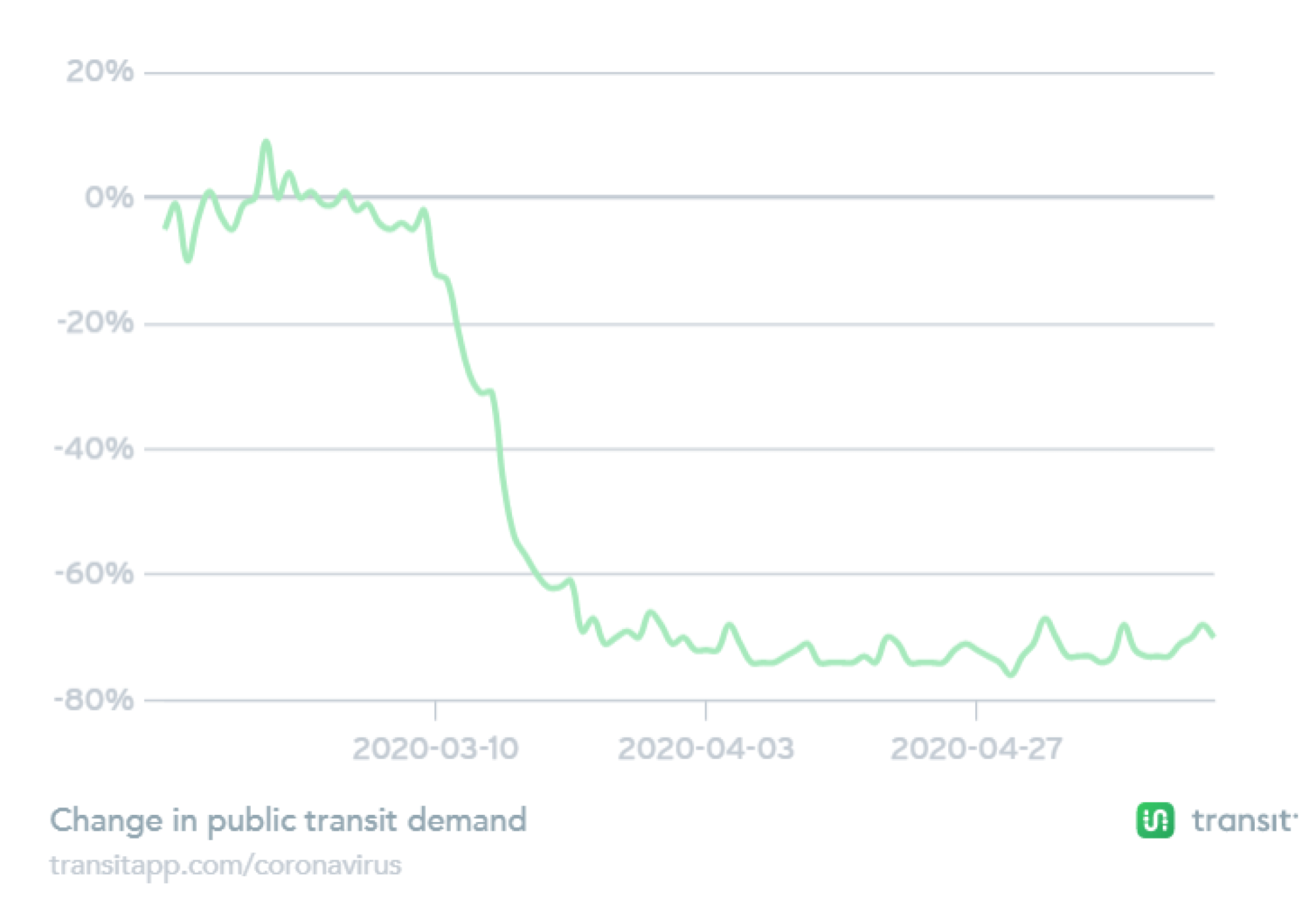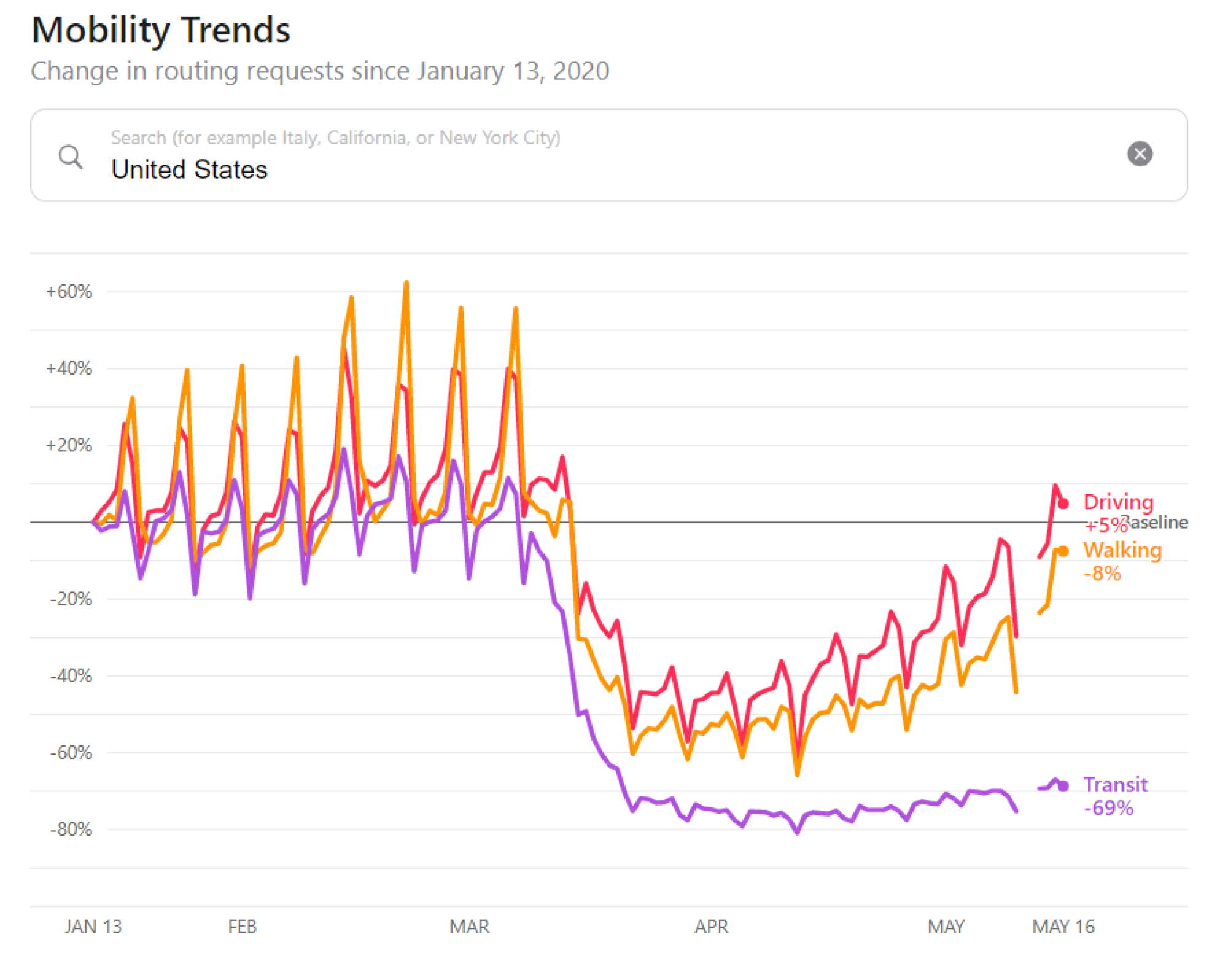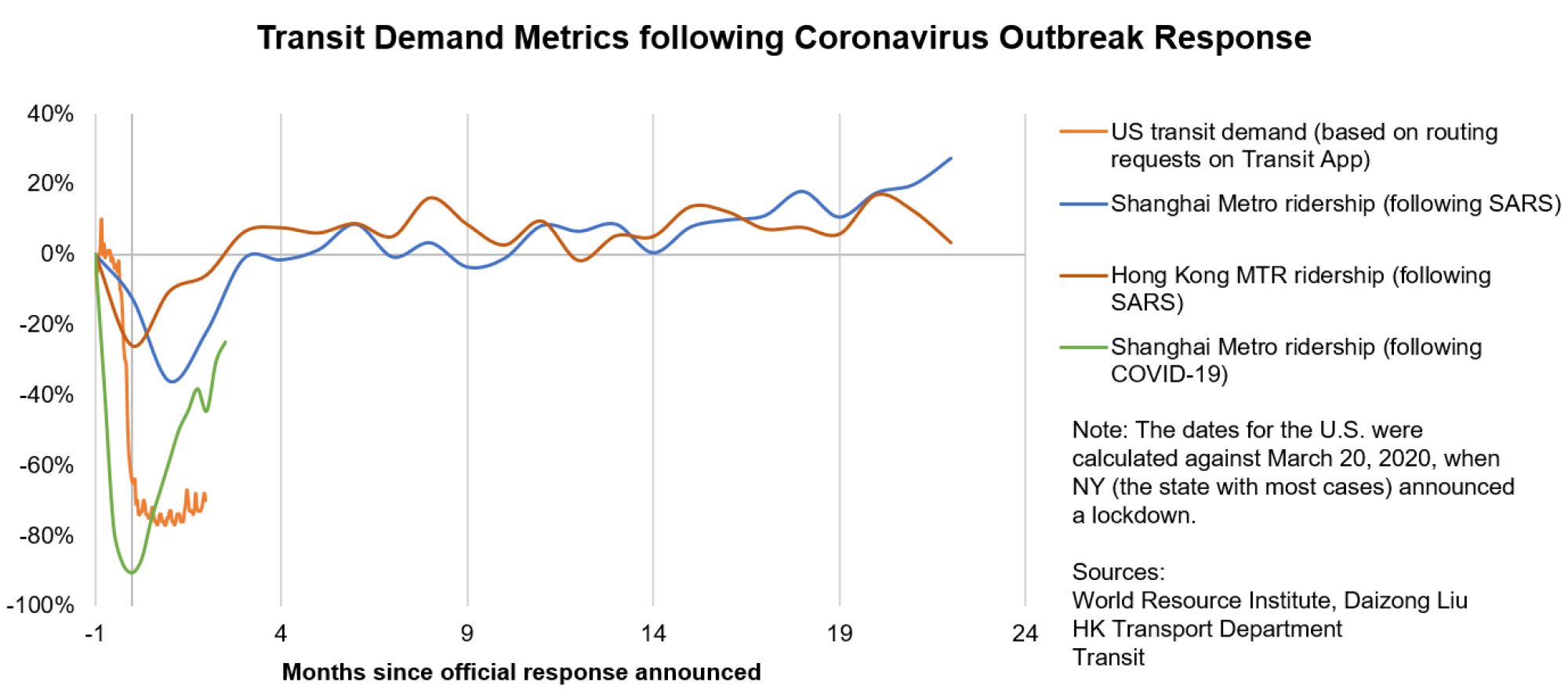With most states in the US having undergone a complete or a partial shutdown, the COVID-19 pandemic has profoundly changed the way we live, get to work, and access resources. As transit ridership worldwide reaches an unprecedented low (like in Japan, US, and China, just to name a few), transit agencies are suffering enormous losses. Many transportation planners are scrambling to figure out what sustainable transportation will look like as we enter the “new normal” and how to promote it in the post-COVID world.
One of the pillars of sustainable transportation is to encourage transit and shared mobility usage in order to minimize the carbon footprint generated by mobility. In other words, sustainable transportation enthusiasts would encourage individuals (usually complete strangers) to ride share and travel in the same vehicle for a majority of their trip. However, the 6-foot social distancing guideline makes shared rides impossible and drastically reduces the number of passengers that can travel together in a transit vehicle.
Another principle is to curtail urban sprawl to make transit and shared mobility cost-effective. However, arguments for urban sprawl based on physical distance alone have been made, claiming that low-density land use makes the virus harder to spread. Has COVID-19 put an end to compact land use and public transportation?

As we look ahead to a long recovery period, it’s not hard to imagine a future where automobile sales and use increase. People who can afford to own a car and have the ability to drive will likely prioritize continued social distancing over costs and opt to not use transit out of fear of infection. In fact, this mode shift has already begun in the US; driving levels have exceeded the baseline, indicating that "revenge travel" is already occurring, while transit demand was just climbing out of the dip according to Apple Maps direction requests.

Based on this shift, is transit as a competitive mode dead? Should we be resigned to a less sustainable and less equitable future in urban mobility? Or are there ways to move forward that allow us to travel safely and still minimize our environmental impacts? Fortunately, we have a bit of history to help guide our thinking.
This is not the first time a public health crisis put transit systems in turmoil...
…In fact, it’s not even the first time this century. The 2002-2004 SARS epidemic, or COVID-19's predecessor, first spread in China before eventually turning many East Asian countries upside down and wiping out more than 50% of transit ridership in major cities such as Beijing, Shanghai, and Hong Kong. Following the epidemic, it took about a year for urban transit ridership to recover and eventually grow.
There are four lessons from the SARS epidemic that US cities and transit agencies should consider during the outbreak and through recovery. You may be questioning how applicable a case from East Asia is when compared to the US, however increased congestion and auto-oriented land use are common features in many Asian cities, as they are in the US. Also, economic conditions and consumer preferences in Asian metro areas have shifted rapidly over the past twenty years, resembling those in metropolitan areas in North America. In Shanghai, for example, metro ridership dropped by more than 80% during the COVID-19 outbreak at the beginning of this year, similar to the current trends in the US.

So what did major East Asian cities learn that might help US cities through our own uncertain future?
1. Don't cut services too quickly.
Even during COVID-19, public transit has an irreplaceable role in our society and should not be completely substituted by private mobility. Keep in mind that many essential workers, whose jobs are not digitized or automated, rely on transit services.
Transit service cuts based on ridership alone would hurt essential workers disproportionately and have a rippling impact on the community they serve. Beyond commuting, it is critical to ensure that everyone has adequate access to essential services and resources especially during this difficult time, in urban and rural areas alike.
This is perhaps one of the reasons why major cities in China did not cut transit services altogether during SARS (although Wuhan did so out of necessity and later faced criticism for not providing patients and health workers with sufficient mobility options). Putting equity aside, reducing transit services at a slower pace than transit ridership loss has two practical benefits:
Transit vehicles will be less crowded so passengers and drivers can practice social distancing. Bus ridership in Beijing dropped by 70% at one point, but service was only cut by 30%, effectively making buses about 50% less crowded.
At reasonable service frequencies, transit remains somewhat competitive over driving and thus a viable mode of transportation. Especially for those of us without a car, it would be much cheaper to wear masks when riding transit than to buy a car, provided that transit still gets us to our destinations as promised.
Fortunately, this is a lesson US transit agencies are taking to heart, with many, including Los Angeles, San Francisco, Boston, Pittsburgh, and more beginning to offer modified services driven by data and demographics that allow for safe riding distances and target those with the greatest needs.
2. Sanitize, ventilate, and communicate!
Of course, "business as usual" is not going to restore our transit ridership after COVID-19, especially if riders feel as though transit vehicles and stations are not clean. Many US transit agencies have been responding promptly, rolling out intensive sanitation schedules. What's important, however, is for clean transit to stick around for the long haul; transit vehicles need to be sanitized on a regular, consistent basis.
In Beijing, Shanghai, and Hong Kong, daily sanitation of transit vehicles is a legacy response to the SARS epidemic that hasn't gone away. During the SARS outbreak, Beijing set up monitoring centers at the first/last stops of key bus routes and required bus drivers to carry sanitation products at all times. Shanghai redesigned its air-conditioned bus vehicles with extra windows (yes, you read that right) to enhance ventilation for everyone onboard. Hong Kong MTR went beyond cleaning their subway trains and stations; passengers were provided with masks, and daily sanitation was performed in its transit-oriented development properties.
Most importantly, what made those measures stick was proactive communication and outreach to customers. Compared to in the early 2000’s during the SARS epidemic, transit agencies today are better equipped with communication tools such as social media campaigns and trip planning software that can make information available to a wider audience much more quickly.
3. Car crashes will challenge Vision Zero.
The mode shift towards automobiles in response to a disease outbreak that we are observing in the US now also happened to Beijing 17 years ago. In the two months following WHO's declaration on the containment of SARS in Beijing, traffic accidents rose by 27.1% and 22.2% (on a year-by-year basis), killing hundreds of people. A number of reasons might have caused this:
There was a surge of new drivers on the road (aka mode shift, which made car dealers happy);
Drivers who got used to the light traffic and engaged in speeding during the outbreak continued to driver faster than the speed limit; and
Traffic police were assigned to outbreak control efforts, and therefore spent less time enforcing traffic rules.
It is very likely - given the high market penetration of automobiles - that the US will witness similar trends. We need a combined approach to encourage positive travel behaviors, slow down traffic, and possibly automate traffic enforcement, which are all in line with the principles of sustainable transportation. To do this, there needs to be collaboration from governments, planning organizations, and regional authorities to curb the aftermath of COVID-19 as it relates to road safety.
4. Support active transportation
Perhaps unexpectedly, bicycle shops in Beijing - along with car dealerships - were packed with customers after the SARS outbreak as residents sought cheap, socially distanced mobility options. If the same trend happens in the US, it should be considered a great opportunity for transit agencies rather than a competition, as public transit usage and active transportation are linked in a way. From an environmental standpoint, we would rather have people walking and cycling (and taking transit when there is no perceived danger) than buying and using cars. Better pedestrian and cycling facilities also improve first-/last mile access to transit and pave the way for a future transit renaissance.
Some cities are already preparing for a future where active transportation plays a much bigger role. Oakland is opening up 74 miles of streets to pedestrians and bikes in its Slow Streets project, while NYC, Denver, Minneapolis, and Burlington VT are following suit, aiming to create more pleasant, safe streetscapes for pedestrians and cyclists. By putting humans back at the center of transportation planning, we unlock mobility options that promote safety and health while lowering emissions.
By understanding the lessons from East Asian cities recovering from SARS, we can be more prepared in expanding sustainable transportation opportunities after COVID-19 by continuously communicating with riders and planning for long-term mode shift.
How Cambridge Systematics can help
With proactive measures and strategic collaboration, it is possible for transit agencies to recover from COVID-19 and continue to be the lead proponent of sustainable transportation. Cambridge Systematics recently launched Mobility Forward, a set of research, tools, and guides for navigating through this difficult time. We want to help transit agencies make the best decisions during and after the pandemic, whether it be delivering essential services; helping workers get to work safely; understanding the impacts on travel behaviors; or planning for a more resilient future. Among our suite of services, here are two immediately relevant resources available:
Understanding COVID-19 travel changes: using anonymized cell phone Location-Based Services data, we can help you understand where people are traveling to and from at a granular level, and how transit service can be shaped to facilitate essential trips.
Connecting people to essential services : Link2Support is an open-source trip planning software designed to help individuals plan safe travel to essential places, like COVID-19 testing locations and grocery stores, using available mode and trip options that are tailored to their needs and circumstances.